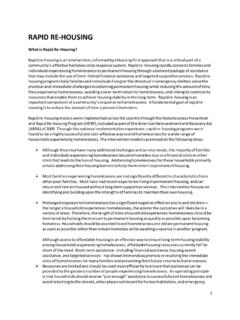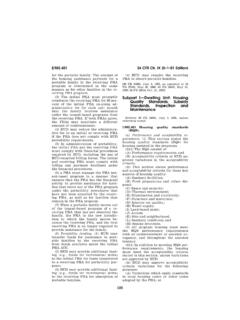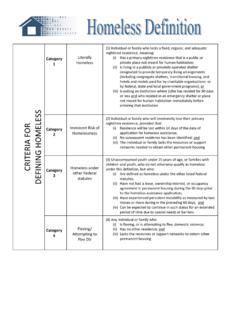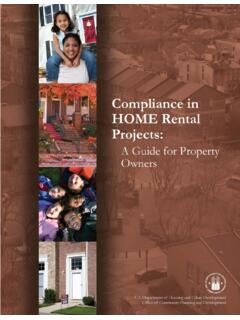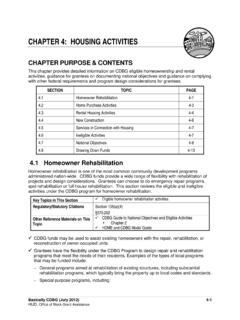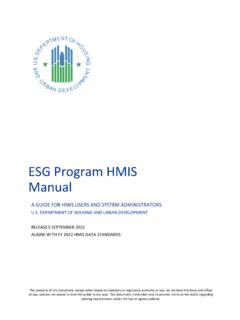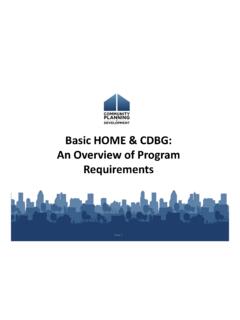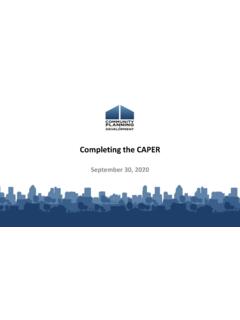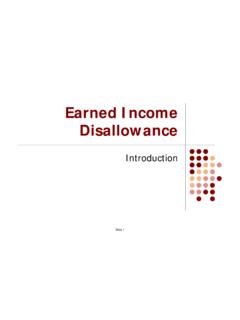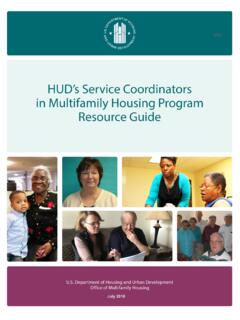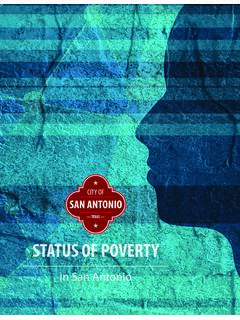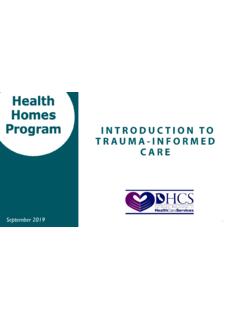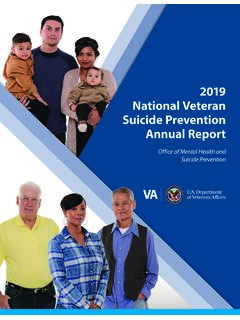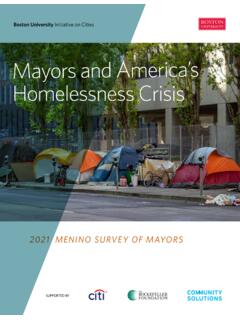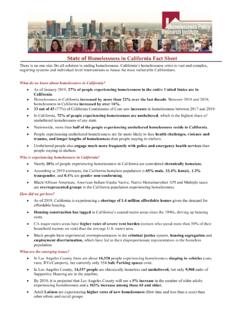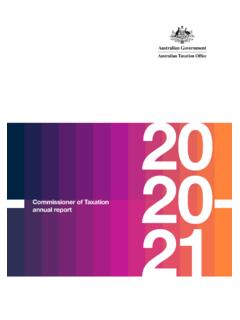Transcription of PATH Program HMIS Manual - HUD Exchange
1 path Program hmis Manual A GUIDE FOR hmis USERS AND SYSTEM ADMINISTRATORS DEPARTMENT OF HOUSING AND URBAN DEVELOPMENT RELEASED SEPTEMBER 2021 Page | 2 Contents Revision History .. 4 Introduction .. 5 path Resources .. 5 Additional hmis Resources .. 5 Definition of Terms .. 6 hmis Project Setup .. 7 Identify Projects for hmis Participation .. 7 Multi-State hmis Implementation .. 7 Identify Project Funding Components .. 7 path Project Descriptor Data Elements .. 8 Organization Information ( ) .. 8 Project Information ( ) .. 8 Continuum of Care Information ( ).. 9 Funding Sources ( ) .. 9 Understanding and Identifying path Project Type:.. 9 Identifying Client Primary Place of Residence .. 9 path Data Collection Requirements .. 11 SAMHSA Virtual Data Collection Guidance During Emergencies, Disasters, and Pandemics.
2 12 Data Element Current Living Situation .. 12 Data Element P1 Services Provided- path Funded .. 12 Data Element P2 Referrals Provided- path .. 13 Data Element P3 path Status .. 15 Data Element P4 Connection with SOAR .. 16 Special Data Collection Instructions .. 16 path Data Collection Workflow .. 17 Automatic Exit and Data Quality .. 19 path Reporting Notes: .. 20 HUD System Performance Measures .. 21 State path Contact hmis Data Collection Decision Tool .. 21 Page | 3 Revision History Date Update March 2015 First Release December 2016 Second Release September 2017 Third Release November 2017 Minor update to the Common Data Elements table for P1 and P2 collection points in path Data Collection Workflow section. September 2018 Minor update to path Reporting Notes section and Data Collection Decision Tool.
3 September 2019 Fourth Release; updates reflect changes made to the 2020 hmis Data Standards June 2020 Fifth Release; updates reflect SAMHSA virtual data collection guidance and clarifies data collection for Data Element P4 September 2021 Sixth Release; updates reflect changes made to the FY2022 hmis Data Standards Page | 4 Introduction The path (Projects for Assistance in Transition from Homelessness) Program hmis Manual is intended to support data collection and reporting efforts of Continuums of Care (CoCs), Homeless Management Information System ( hmis ) Leads, State path Contacts (SPCs), and path Program grantees. path Program participation in hmis provides for client care coordination and the generation of the path annual report , in addition to other benefits to clients and path Program grantees.
4 This Manual provides information on hmis project setup and data collection guidance specific to the path Program . The guidance provided in this document aligns with requirements around using hmis as stated by the Substance Abuse and Mental Health Services Administration (SAMHSA) and refers to the data elements required of path Program grantees to enter in an hmis as established in the FY 2022 hmis Data Standards. This document is not a replacement for any specific Program guidance, requirements, regulations, notices, and training materials on the path Program . This Manual only addresses the use of hmis for the path Program . path Resources Additional information about the path Program and its requirements can be found on the path Program page including: path annual report Manual path hmis Participation Guidance path Data Exchange (PDX) path hmis Resources Additional hmis Resources o There are a variety of documents available on the HUD Exchange hmis page that detail all hmis Data and Technical Standards, Federal Partner Information, and information about hmis forums for hmis Leads, System Administrators, and Vendors.
5 O The 2022 hmis Data Standards page contains a suite of hmis Data Standard resources, which are briefly described below. Each of the documents has a specific purpose and intended audience. The hmis Lead should be familiar with all the documents and collectively use them as their hmis reference materials along with specific materials provided by the software provider. FY2022 hmis Data Manual represents the foundation for the data contained within an hmis , project setup instructions, and data collection instructions. FY2022 hmis Data Dictionary Table Shells contain the data element tables with relevant programming instructions, system logic and other issues to be used by vendors for hmis programming. The information in the tables shells aligns with the information contained herein.
6 O Data Exchange Resources: FY2022 CSV Programming Specifications FY2022 XML Programming Specifications hmis Federal Partner Program Manuals Federal Partner Reporting and Programming Specifications hmis Project Setup Tool To ask a question about any path Program hmis requirement, go to the Ask A Question section of the HUD Exchange . Please be sure to select hmis for your question under My Question is Related To. Federal hmis and path Program staff are working together to answer questions submitted on Ask A Question related to path and hmis . If you encounter a path related question that is specific to the path Data Exchange (PDX), then go to the Ask A Question section of the HUD Exchange . Please be sure to select PDX for your question under My Question is Related To.
7 Page | 5 Definition of Terms path providers conducting street outreach may encounter challenges related to hmis data collection due to factors such as the infrequency of contacts or the length of time it takes to collect accurate information from a client, among others. The data collection process is designed to support path projects as they connect to individuals and families that are experiencing homelessness, and as relationships are built between the street outreach worker and the client. Several key terms specific to the path Program are defined below: Contact: An interaction between a path -funded worker(s) and an individual who is potentially eligible for path or enrolled in path . Contacts may range from a brief conversation between the path -funded worker and the client about the client s well-being or needs, to a referral to service.
8 A contact must always include the presence of or interaction with the client the facilitation of a referral between a path -funded worker and another case manager or service provider without the involvement of the client would not be considered a contact. A contact may occur in a street outreach setting or in a service setting such as an emergency shelter or drop-in center. Contacts are recorded in hmis using Current Living Situation (data element ). Engagement: The point at which an interactive client relationship results in a deliberate client assessment or the beginning of a case plan. Engagement is a one-time event within any given project enrollment, may occur on or after the Project Start Date (data element ), and must occur prior to path enrollment (recorded in hmis using path Status (data element P3)) and Project Exit Date (data element ).
9 Clients cannot be enrolled in path without being engaged. Although some interactions with a client may result in a positive outcome, such as assisting a client to access a shelter bed, without a deliberate client assessment or the beginning of a case plan, those interactions are not considered to be an engagement. The assessment does not have to be of a clinical nature, and neither HUD nor SAMHSA have established minimum criteria for what the assessment must include, other than the client must deliberately engage with the worker(s) to resolve the housing crisis. Engagement is recorded in hmis using Date of Engagement (data element ). Enrollment: The point at which the path -funded worker can determine if a person is eligible for the path Program . Only persons eligible for path can receive a path -funded service or referral.
10 Additionally, the path -eligible individual and a path provider must have mutually and formally agreed to engage in services and the provider has initiated an individual file or record for that individual. Enrollment is recorded in hmis using path Status (data element P3), which provides additional information regarding path enrollment. Project Exit: SAMHSA has not established a policy regarding the specific amount of time that must pass from the date of last contact for the client to be considered exited from the path project. However, your local State path Contact (SPC) should set a local statewide benchmark for this. Please contact your SPC directly for information on local standards for project exit. Project Exit is recorded in hmis using Project Exit Date (data element ).
